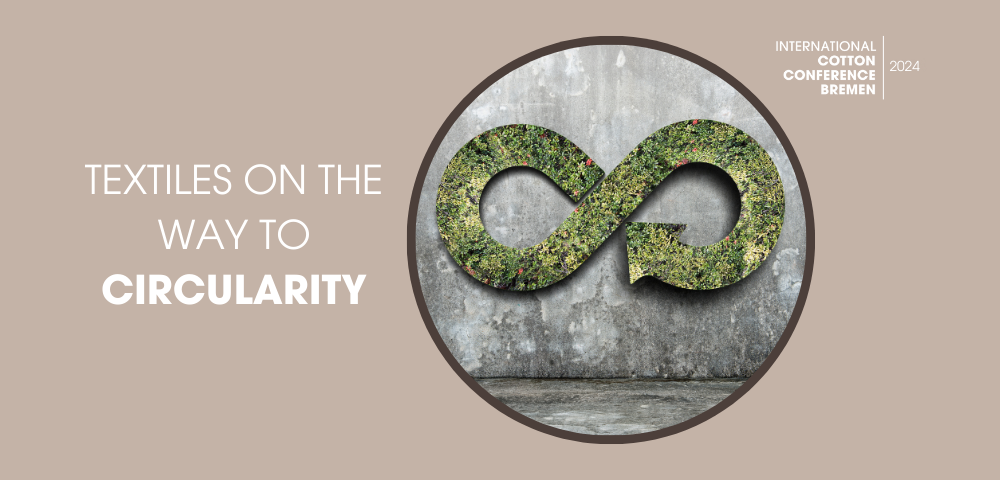– International Cotton Conference Bremen 2024 –

Based on the goal of a more sustainable textile industry on the way to defossiliation, Prof. Stefan Schlichter from Augsburg University of Applied Sciences presented the current status and concepts of textile recycling. His presentation at the International Cotton Conference Bremen in March 2024 focused on the path towards a more circular textile industry and innovative research approaches to support it.
According to Stefan Schlichter, it is urgently needed to mitigate the impacts of rising energy prices, diversify the gas supply for the EU, and accelerate the clean energy transition.
The three pathways toward defossiliation are to use more biomass, to reduce the CO2 footprint, and recycling, and all three pathways should be used in combination.
The State and Challenges of Recycling
In the EU today, because of the linear economy based on production, use and disposal, only 1% of used textiles are recycled in a closed loop system to become fibres again, and 73% are recycled for energy (burnt) or landfilled. The blending of fibres in textile products makes recycling difficult. Textile waste is much more than just clothes, as technical textiles and hygiene textiles are major parts of the total textile supply.
Processes in the Circular Economy
In a circular textile economy, recycled materials are used to make high-quality products, rather than being burnt or landfilled. Circularity actually involves two circles, one circle in which used textiles are sorted, repaired and reused, and another circle where fibres are recovered from used textiles and remade into high-quality products.

Waste Pyramid
The first priority in the inverted waste pyramid is prevention. Prevention of overproduction is the most important step in reducing waste in the textile value chain. Next steps include reuse, recycling, energy-intensive recovery of fibres, and finally disposal. There are different technologies for recycling textile waste, including mechanical, thermos-mechanical, solvent-based separation, thermos-chemical and depolymerization. Chemical recycling is not yet sufficiently developed to be market-ready.
Shortening of Fibers Through Recycling
Mechanical recycling is an available technology, but fibres are shortened in each iteration. It is also the case in polymer recycling, that molecules get shorter with each recycling iteration.
Strategies to deal with shorter fibres include cascading applications using blends with virgin fibres (from lingerie to t-shirts to fibre board), short-fibre separation and use in appropriate applications such as construction and geothermal products, and strategies to maintain staple length.
Approaches for Innovations in the Recycling of Textiles
An example of cradle-to-cradle circularity is web-based composites (WBC). Carbon is expensive so there are incentives to recycle. Carbon fibres retain their stiffness through recycling iterations and can be used repeatedly to produce composites used in planes, and other vehicles.
Recycling Atelier Augsburg (Recycling Studio Augsburg) is developing new approaches to innovation for the recovery and use of textiles. New products and processes are developed on a small scale to prove concepts for the recycling of used textiles.
Challenges in the Future
Textile sorting is labor intensive and imprecise and needs to be automated, therefore an ongoing project is AI-based sorting. The project aims to automatically identify the type of article, whether woven or knitted, whether buttons and zippers are present, and other characteristics.
In summary, the main challenges in adoption of textile recycling at scale are to optimize
1) chemical and
2) mechanical recycling,
3) to develop automatic sorting,
4) to optimize take-back and textile waste management systems, and
5) research into new recycling technologies.

